Australia’s 5 best outback station stays
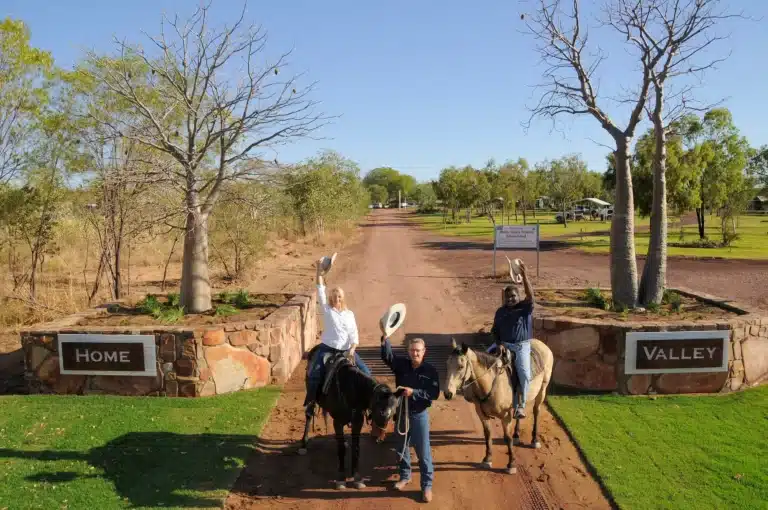



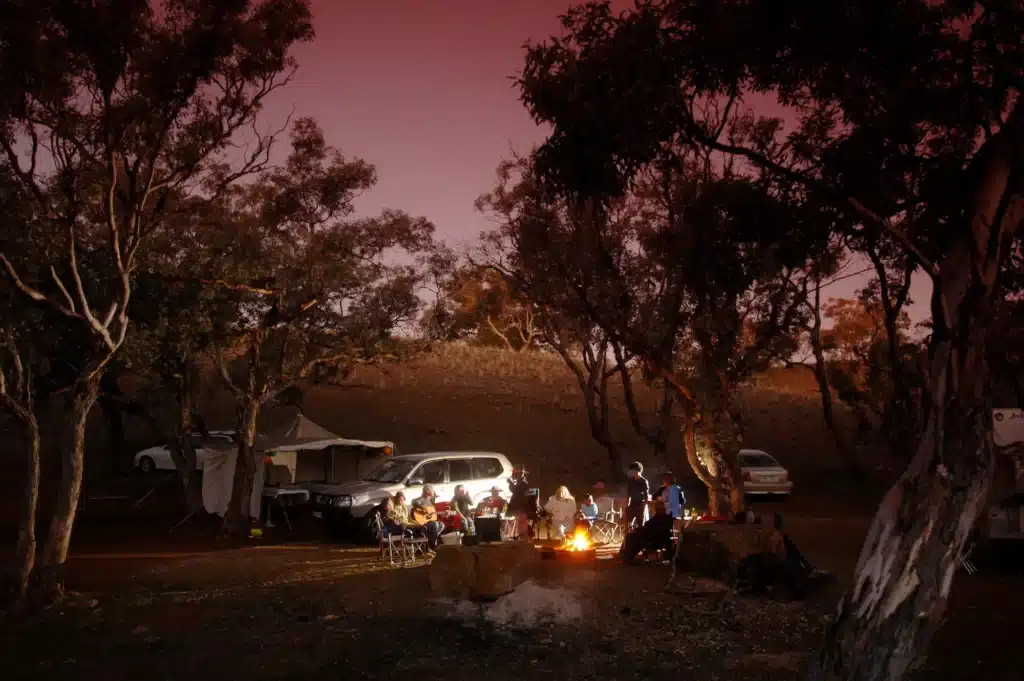
Forget $100-a-night caravan parks with their postage-stamp sites and noisy neighbours. Instead, outback station stays offer something profoundly satisfying: pulling up at a working cattle station, unhitching the van under a sprawling gum tree, and settling in for the night with nothing but stars and silence for company.
Moreover, outback station stays provide something increasingly rare in modern Australia. These authentic experiences unfold on multi-generational family properties where the connection to country runs deep. Consequently, you’re not just a customer at these places. You’re a guest on someone’s home, welcome to share in their slice of Australia’s heartland.
And here’s the kicker: most outback station stays cost 30-70% less than commercial caravan parks. While coastal parks are slugging travellers $80-100 a night for a powered site, these outback station stays offer the same amenities (often better maintained) for $30-60. Furthermore, some even offer free unpowered camping. In an era where caravan park costs have skyrocketed, outback station stays represent extraordinary value for money.
However, it’s not just about saving dollars. Outback station stays deliver experiences you simply can’t replicate at a caravan park. For instance, you’ll find self-guided 4WD tracks through working properties, riverside camping with kilometres of private frontage, and station tours led by families who’ve been on the land for seven generations. Additionally, you get the chance to genuinely disconnect from the world while still enjoying hot showers and flush toilets.
Before heading out on any outback road trip, ensure your vehicle is properly prepared with essential outback safety equipment.
We’ve updated our list of Australia’s best outback station stays for 2025. Specifically, we’ve verified current facilities, pricing, and accessibility. Four of our original five recommendations remain outstanding options, while one has undergone fundamental changes that necessitated a replacement. Therefore, here are the five outback station stays that deliver the perfect balance of authenticity, facilities, and value.
After extensive research, these outback station stays represent the best options across Australia for authentic cattle station experiences:
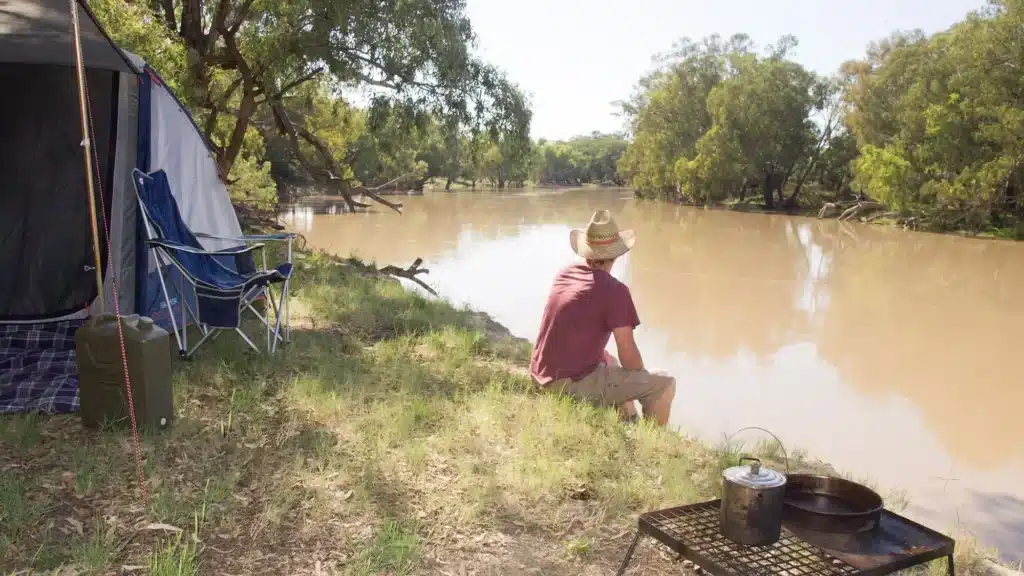
The verdict: Best for families and first-timers, with a sealed road now making this accessible to all RV types
Trilby Station is outback station stays done right. This 320,000-acre working sheep and cattle property has been in the Murray family for seven generations. Moreover, that deep connection to country shows in every detail. Station owner Liz Murray and her family have created something special here: authentic outback hospitality with genuinely excellent facilities, all delivered with the kind of warmth that makes strangers feel like old mates within minutes.
The game-changer since 2018? The 25km approach from Louth is now sealed. Consequently, this transforms Trilby from a “dusty outback adventure” into a destination accessible to any RV or caravan. Big rigs, family vans, hired motorhomes – all welcome. Yet despite this improved access, Trilby has lost none of its remote, authentic character.
The station offers 16 absolute riverfront campsites along 3km of private Darling River frontage. These aren’t “vaguely near the river” sites. Instead, these are front-row positions where you can cast a fishing line from your camp chair. Additionally, there are 9 bush campsites around a billabong (currently dry but magnificent when flowing), and 4-5 powered sites near the amenities for those who need reliable electricity.
Facilities are exceptional: hot showers, flush toilets, a sparkling swimming pool, camp kitchen, and individual fire pits at each site with complimentary starter wood. Furthermore, every camper gets free use of yabby nets (the kids will love this). The self-guided Mud Map drives through the property are worth the trip alone. These are detailed 4WD tracks with handwritten notes from the Murray family, pointing out everything from historic shearing sheds to the best birdwatching spots. With 135 recorded bird species on property, twitchers are in paradise.
Current pricing (as at October 2025) remains remarkably affordable: $30 per couple for unpowered sites, $35 for families, and $45-50 for powered sites (seasonal pricing applies). This includes pool access, yabby nets, and the Mud Map drives. Compare that to $80-100 at a commercial caravan park and the value proposition becomes bleedingly obvious.
Trilby forms part of the historic Dunlop Station, birthplace of the world’s first mechanical shearing in 1888. That history permeates the property, from the restored woolshed to the stories Liz shares over a cuppa. This is living history, still very much a working station running thousands of head.
Book well ahead for powered sites, especially November-March. The riverfront unpowered sites operate mostly first-come, but calling ahead is wise during peak season (April-October). Liz Murray is the kind of host who remembers repeat visitors by name and treats everyone like family.
Access: 2WD friendly (sealed road from Louth), suitable for all RVs and caravans
Best season: April-October (peak); November-March (hot but quieter)
Booking: Essential for powered sites
Contact: 02 6874 7420 or [email protected]
Website: trilbystation.com.au
What you’ll pay: $30-50/night depending on power and season (October 2025 pricing)
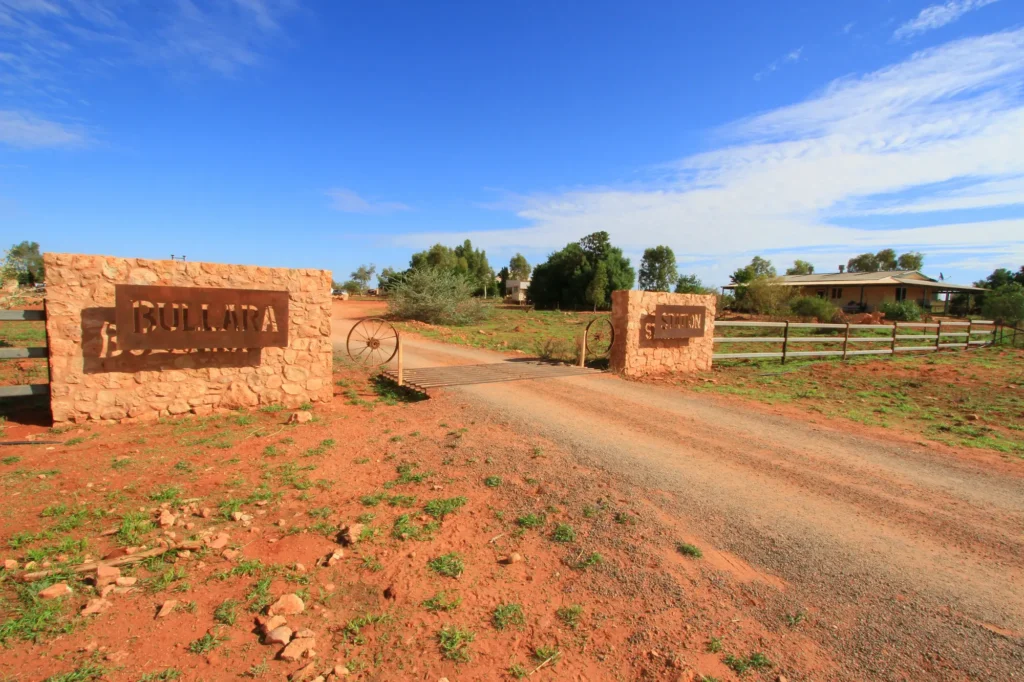
The verdict: Best for beach lovers who want coral coast access without the crowds
Bullara Station offers something increasingly rare along Western Australia’s spectacular Coral Coast: space. While nearby Coral Bay and Exmouth heave with visitors during peak season, Bullara delivers the same turquoise waters, pristine beaches, and world-class snorkelling. However, it does so with genuine breathing room and authentic station hospitality.
This working sheep and cattle station spans 103,000 hectares between the Ningaloo Marine Park and the Kennedy Range. Consequently, this puts campers within easy reach of both reef and ranges. The station’s beaches are legendary, particularly Maud’s Landing with its protected bay, perfect for families. This isn’t “nice beach by outback standards”. Instead, this is genuinely spectacular coastline that would be famous anywhere else but remains wonderfully uncrowded thanks to Bullara’s semi-remote location.
The station has evolved considerably in recent years with new ownership investing heavily in facilities. Therefore, campers now enjoy hot showers, flushing toilets, a camp kitchen, and powered sites. Additionally, unpowered beach and bush camping options remain available. The station shop stocks basics, cold drinks, and local knowledge. Mobile reception (Telstra) has improved markedly, though don’t expect Netflix streaming speeds.
What makes Bullara special beyond the facilities is the genuine station experience. This isn’t a resort masquerading as a station. You’re camping on a working property where cattle and sheep still outnumber tourists. Furthermore, the rhythms of station life continue regardless of visitor numbers. Yet the owners understand what grey nomads and families need: clean facilities, reliable power, and detailed local knowledge about the best fishing spots, walking tracks, and coral viewing locations.
The snorkelling here rivals anything at Ningaloo Reef. Wade out from several beaches and you’re swimming with turtles, rays, and reef fish within minutes. Fishing is excellent for those with the right licence. The station’s position between reef and range means you can spend mornings exploring limestone gorges in the Kennedy Range, then cool off with afternoon swims at deserted beaches.
Access requires a 4WD or high-clearance vehicle due to corrugated gravel roads (approximately 80km from Minilya Roadhouse on the North West Coastal Highway). The corrugations are manageable, not extreme. However, a standard sedan or low-clearance camper will struggle. Off-road caravans and camper trailers are fine. Standard highway vans should consider other options.
If you’re considering hybrid caravans for outback travel, Bullara’s corrugated access roads are perfect for testing their off-road capabilities.
Pricing sits in the mid-range for WA outback station stays, with rates varying by season and site type. Expect $40-60 per night for most sites (verify current rates when booking, as pricing was being updated at time of research).
Access: 4WD or high-clearance vehicle recommended (corrugated roads)
Best season: April-October (winter/spring for comfortable temperatures)
Booking: Recommended, especially May-September
Contact: Check bullarastation.com.au for current details
Website: bullarastation.com.au
What you’ll pay: Approximately $40-60/night (verify current rates, October 2025)
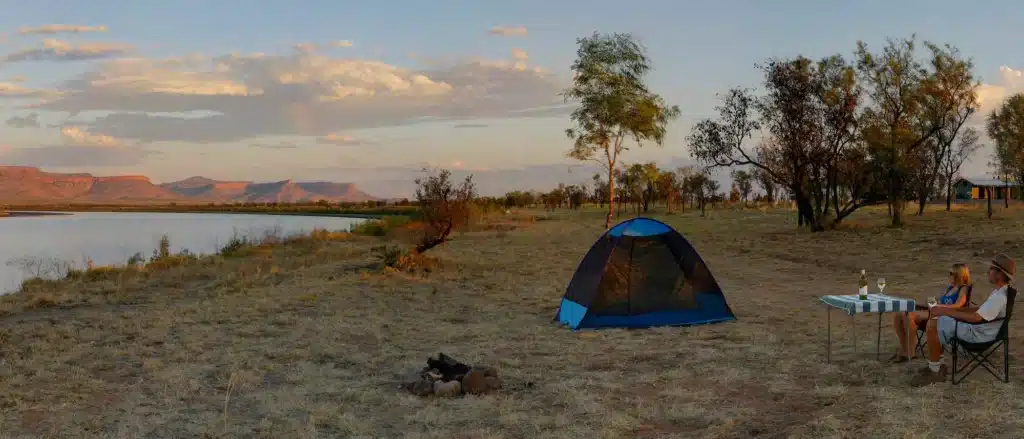
The verdict: Best for cultural immersion and Kimberley adventure, but verify facility status before booking
Home Valley Station occupies a unique position in Australian tourism. Since 2021, this 249,000-hectare working cattle station has been managed by Balanggarra Ventures. Consequently, this makes it the largest Indigenous-managed tourism resort in Western Australia. This represents a landmark development: Traditional Custodians managing tourism on their own Country, employing 85% Indigenous staff, and offering genuine cultural experiences rather than token acknowledgement.
The station’s position is genuinely spectacular. Sandwiched between the Pentecost River and the towering Cockburn Ranges on the Gibb River Road, this is Kimberley scenery at its most dramatic. Furthermore, campers can choose between the Homestead Camp with 16 powered sites and multiple unpowered positions, or the Pentecost River Bush Camp 4km away for those seeking riverside solitude. Both offer hot showers, flush toilets, and access to the swimming pool and Dusty’s Bar & Grill (dinner bookings essential).
What sets Home Valley apart is the opportunity for Aboriginal-guided cultural experiences. These include art workshops, bush tucker walks, and stories of Balanggarra Country told by those whose connection stretches back millennia. This isn’t performative culture. Instead, it’s the real thing. Additionally, the station features seven self-guided walking trails, excellent barramundi fishing in the Pentecost River (May or September/October best), and the Gibb River Road’s best playground for travelling families.
Now for the honest assessment: recent reviews have been decidedly mixed. While location, cultural experiences, and staff friendliness receive consistent praise, multiple 2024-2025 reviews mention maintenance issues. These include facility problems and inconsistent service standards. Empty pools, uncleaned amenities, and rude staff interactions appear in enough reviews to warrant caution. This may reflect teething problems with the management transition, staffing challenges in remote locations, or seasonal timing issues. The Indigenous management success story deserves support. However, travellers should verify current facility status when booking.
Pricing reflects the limited accommodation on the Gibb River Road. Powered sites run approximately $80 per night (based on 2024 reviews; official pricing not published online). That’s premium territory, justified by the location and scarcity of alternatives. However, the facilities need to match that price point.
Access requires 4WD capability for the Gibb River Road, which features two water crossings and mix of sealed/unsealed sections. Off-road caravans are suitable. However, standard caravans are not. The station is 120km west of Kununurra.
Seasonal closure is absolute: May-October only, with the wet season (November-April) completely shutting operations. The 2024 season opened 13 May.
Access: 4WD essential (Gibb River Road), off-road caravans only
Best season: May-October only (wet season closure November-April)
Booking: Essential for powered sites (only 16 available)
Contact: bookings@balanggarra.com.au
Website: homevalley.au
What you’ll pay: Approximately $80/night powered (October 2025 estimate)
Important: Verify current facility condition when booking; recent reviews highly mixed
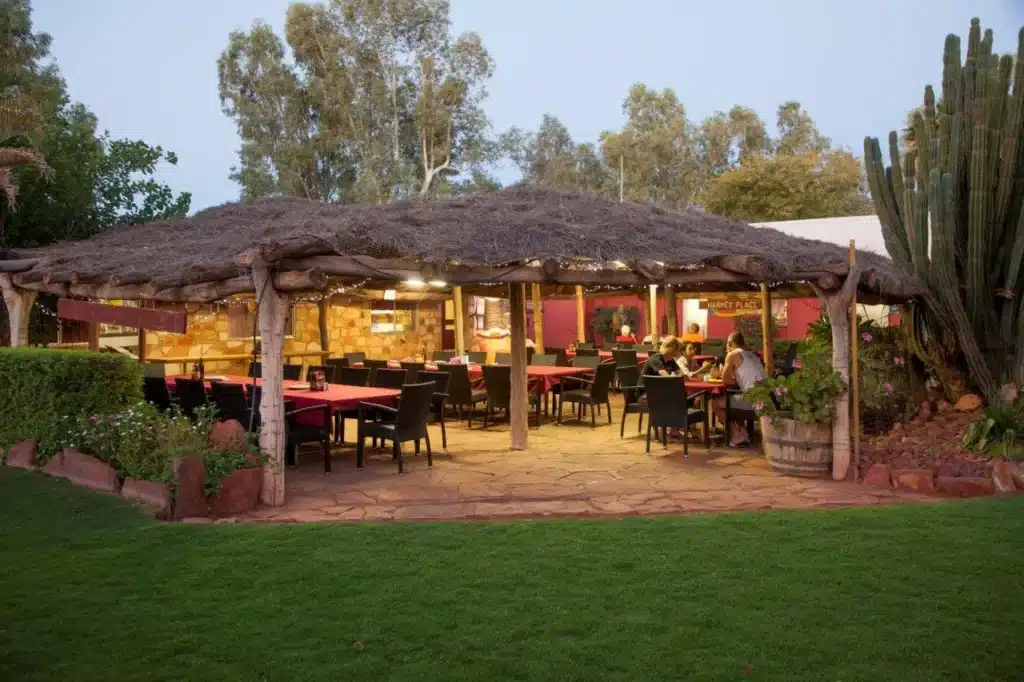
The verdict: Best value proposition, with free unpowered camping and excellent base for Uluru-Kata Tjuta-Kings Canyon triangle
Curtin Springs Station delivers the most compelling value equation of any accommodation in Central Australia. Let that sink in: free unpowered camping, unlimited sites on a million-acre working cattle station, 85km from Uluru. The Severin family has been operating here for seven decades. During this time, they’ve been running 4,000-4,500 head of cattle while welcoming travellers as Australia’s first Wayside Inn in the Red Centre.
The free camping comes with a small caveat: hot showers cost $4 per person per use (applies to all campers, powered or unpowered). Even factoring that in, two people camping for three nights pay $24 total. Compare that to $80-100 per night at Yulara’s caravan parks and you understand why savvy travellers base themselves at Curtin Springs for their Uluru exploration.
The station offers 8 powered sites ($55/night, bookings essential) for those needing reliable electricity. Additionally, unlimited unpowered sites operate first-come, first-served. Facilities are admittedly basic, as expected for remote locations: hot showers (paid), toilets, BBQ facilities, limited camp kitchen, and a swimming pool. There’s no dump point on-site. However, the trade-off for bargain pricing and million-acre views seems more than fair.
What elevates Curtin Springs beyond a simple budget option is its authentic working station character. This isn’t a caravan park with cattle props. Instead, the Severin family still runs a genuine cattle operation, and campers are welcome to explore (within reason). The station shop sells fuel, groceries, takeaway meals, and the best station-raised beef you’ll taste. Furthermore, sunset beers at the outdoor bar, watching the light paint Uluru and Kata Tjuta in impossible colours, costs nothing extra.
Location is the secret weapon here. Curtin Springs sits perfectly positioned for the Uluru-Kata Tjuta-Kings Canyon touring triangle. Day trips to all three are entirely feasible: Uluru is 85km west (1 hour), Kings Canyon is 200km north (2 hours), and Kata Tjuta shares Uluru’s access. Consequently, campers save hundreds on accommodation while seeing exactly the same sights as resort guests.
Access couldn’t be simpler: sealed Lasseter Highway all the way, suitable for any RV or caravan including big rigs. The 360km drive from Alice Springs takes 3.5-4 hours. No 4WD requirements, no corrugations, no drama.
The station’s popularity has increased significantly since our 2018 article. Peak season (April-October) sees healthy numbers. Therefore, arrive early for the best unpowered sites, or book powered sites well ahead. The winter months (June-August) bring cool nights but perfect daytime temperatures.
Recent reviews praise the authentic outback experience and exceptional value. However, they acknowledge the facilities are basic and somewhat rundown. This is the trade-off for remote location and budget pricing. Those expecting resort standards will be disappointed. However, those seeking genuine outback atmosphere and extraordinary value will be delighted.
Access: 2WD friendly (sealed Lasseter Highway), suitable for all RVs and caravans
Best season: April-October (cooler); November-March (extreme heat)
Booking: Unpowered is first-come; powered sites must be pre-booked
Contact: 08 8956 2906 or enquiries@curtinsprings.com
Website: curtinsprings.com
What you’ll pay: FREE unpowered (plus $4/person for showers), $55 powered (October 2025 pricing)
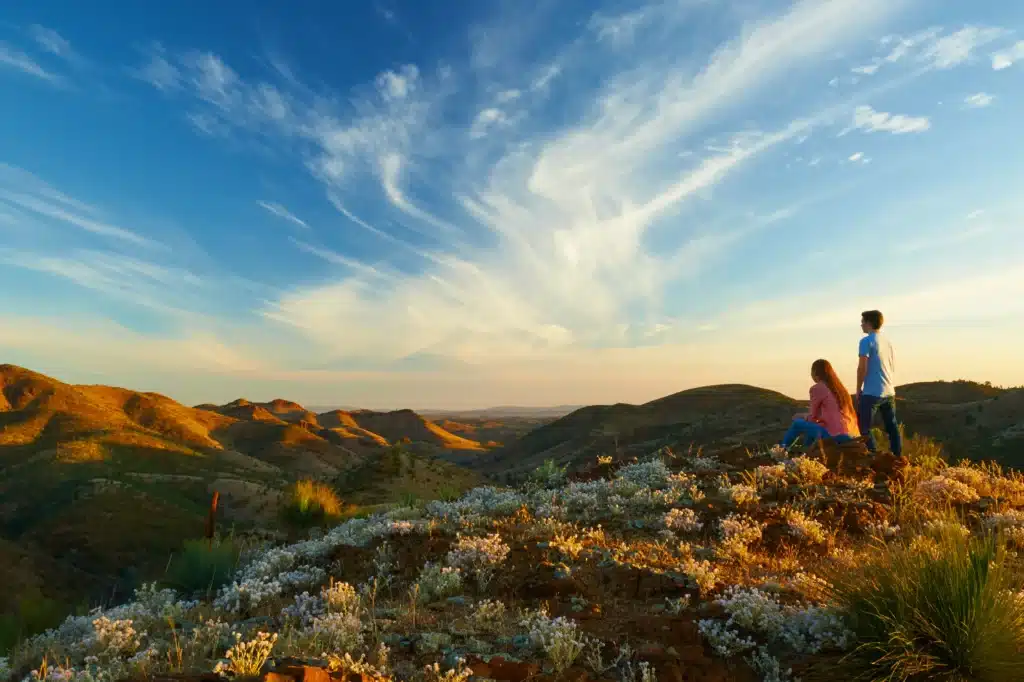
The verdict: Best all-rounder for service, facilities, and Flinders Ranges access
Willow Springs Station gets everything right. This is outback station stays refined to an art form. Specifically, it combines authentic working property character with facilities and service that would make many caravan parks blush. The Fargher family has been here since 1880. Moreover, their deep connection to country shows in how meticulously they’ve crafted the visitor experience.
The station sprawls across the spectacular Flinders Ranges. Consequently, campsites nestle among ancient river red gums along Willow Springs Creek. This isn’t flat, featureless camping. Instead, it’s genuine Flinders Ranges country with rocky outcrops, soaring gums, and mountain backdrops that glow impossible shades of purple and orange at sunset. The property borders Ikara-Flinders Ranges National Park. Therefore, this puts iconic spots like Wilpena Pound, Brachina Gorge, and the Heysen Trail within easy day-trip range.
The Flinders Ranges region offers numerous outback station stays and caravan stops worth exploring.
Facilities exceed expectations: spotless amenities blocks with hot showers and flush toilets, excellent camp kitchen, swimming pool, dedicated kids’ play area, and well-maintained powered sites with quality power pedestals. Furthermore, the station shop stocks supplies, local knowledge, and genuine Flinders Ranges hospitality. Recent reviews consistently praise the exceptional cleanliness and maintenance. Additionally, multiple travellers note this sets the bar for what outback station stays can achieve.
What distinguishes Willow Springs is the attention to detail. Sites are thoughtfully spaced, each with a sense of privacy despite the station’s popularity. The self-guided station drive takes visitors through working areas (when safe), past historic buildings, and to spectacular lookout points. Walking tracks radiate from the camping areas, from short strolls to longer hikes showcasing Flinders Ranges geology.
The Fargher family’s hospitality is legendary. Staff genuinely care about ensuring visitors experience the best of the Flinders Ranges. Specifically, they offer detailed advice about national park highlights, road conditions, and seasonal considerations. This is hospitality as it should be: professional yet personal, helpful without being intrusive.
Pricing reflects the quality: $38-80 per night depending on site type and occupancy (2024/2025 rates). That’s mid-to-premium pricing. However, you’re paying for facilities and service that justify the cost. The station offers various accommodation options beyond camping, including cottages and glamping. Therefore, this makes it suitable for multi-generational family groups with varying comfort needs.
Access is straightforward: sealed roads to the station, though exploring deeper into the Flinders Ranges rewards 4WD capability. Standard caravans and 2WD vehicles can access the station and many nearby attractions. The station is approximately 430km north of Adelaide (5 hours) via Hawker.
Seasonal considerations matter in the Flinders Ranges. Spring (September-November) brings wildflowers and comfortable temperatures. Summer (December-February) can be stinking hot. Autumn (March-May) and winter (June-August) offer excellent weather for bushwalking, though nights get genuinely cold.
The station’s popularity means advance booking is essential during peak periods (school holidays, long weekends, wildflower season). The Fargher family’s reputation for excellence ensures Willow Springs stays consistently busy with return visitors and word-of-mouth recommendations.
Access: 2WD friendly (sealed roads), suitable for all RVs and caravans
Best season: March-November (autumn/winter/spring ideal)
Booking: Essential, especially peak periods
Contact: 08 8648 4043 or [email protected]
Website: willowsprings.com.au
What you’ll pay: $38-80/night depending on site type and occupancy (October 2025 pricing)
Most outback station stays lack dump points, with Bullara Station a notable exception. Therefore, plan your trip accordingly: empty tanks before arrival, use facilities conservatively, and identify nearby towns with dump points if you’re staying extended periods. WikiCamps Australia and Camps Australia Wide are invaluable for locating public dump points along your route.
Unlike caravan parks with 50+ powered sites, outback station stays typically offer 8-20 powered positions maximum. Consequently, these book out 2-4 weeks ahead during peak seasons. If you absolutely need shore power, book the moment you finalise travel dates. Otherwise, consider unpowered sites with generator use (check station policies) or solar panel setups for off-grid camping.
Two of our five picks (Trilby and Curtin Springs) are sealed all the way, suitable for any vehicle. Willow Springs is sealed access with 2WD capability. However, Bullara requires high-clearance or 4WD for corrugated approach roads. Additionally, Home Valley demands 4WD for the Gibb River Road. Don’t attempt 4WD-required outback station stays with unsuitable vehicles. Otherwise, you’ll wreck your rig and ruin your trip.
You’re a guest on someone’s working property, not a caravan park customer. Therefore, respect station rules, stay in designated areas, ask permission before exploring, and remember cattle and sheep operations continue regardless of tourism. Furthermore, close gates, drive slowly on station tracks, and understand that you may be asked to move or avoid certain areas during mustering or other station activities.
Most outback station stays offer limited to zero mobile coverage. Telstra typically performs best in remote areas. However, even Telstra drops to nothing at many locations. This is part of the appeal for many visitors. Nevertheless, plan accordingly: download offline maps, pre-book accommodation ahead, and inform family of your itinerary before heading off-grid.
Home Valley closes entirely November-April (wet season). Northern outback station stays become impossibly hot November-March (40°C+ days are normal). Conversely, southern stations get genuinely cold in winter (sub-zero nights). Therefore, check seasonal operating dates, pack appropriate clothing, and consider whether you want to visit during extreme weather periods.
A typical coastal caravan park charges $80-100 per night for powered sites. Increasingly, they add fees for everything from visitors to rubbish. In contrast, outback station stays typically charge $30-80 (with one offering free camping). Moreover, they often include extras like station tours, swimming pools, and property access. For a week’s stay, you’re saving $200-400 minimum, with far more authentic experiences thrown in.
Outback station stays represent one of Australia’s last genuine travel bargains: extraordinary value, authentic experiences, and warm hospitality on multi-generational properties where connection to country runs deep. In an era where caravan parks increasingly treat travellers like revenue units rather than guests, the personal touch at outback station stays feels refreshingly human.
Our five picks deliver different experiences but share common threads: working properties where cattle and sheep still matter more than tourism, facilities maintained to genuinely high standards, and families who take pride in sharing their slice of Australia with visitors. Whether you’re seeking Kimberley adventure, Red Centre access, coastal beauty, or Flinders Ranges exploration, these outback station stays deliver experiences no caravan park can replicate.
The value proposition has never been stronger. With caravan park costs surging to $100+ per night, outback station stays at $30-80 (or free at Curtin Springs) offer 30-70% savings while delivering superior experiences. Consequently, that’s money available for fuel, attractions, or simply extending your trip.
Book ahead for powered sites, pack for off-grid capability even at stations with facilities, and embrace the station stay ethos: you’re a guest, not a customer. Respect that distinction, and these properties will reward you with experiences you’ll remember long after the dust has settled and the outback has worked its magic on your soul.
All pricing current as at October 2025. Verify rates, facilities, and seasonal closures when booking, as conditions can change in remote locations.